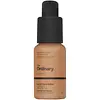What's inside
What's inside
 Key Ingredients
Key Ingredients

 Benefits
Benefits

 Concerns
Concerns

 Ingredients Side-by-side
Ingredients Side-by-side

Cyclopentasiloxane
EmollientWater
Skin ConditioningCaprylyl Methicone
Skin ConditioningCoconut Alkanes
EmollientTrimethylsiloxysilicate
EmollientPEG-9 Polydimethylsiloxyethyl Dimethicone
EmulsifyingCoco-Caprylate/Caprate
EmollientDimethicone/PEG-10/15 Crosspolymer
Cetyl Diglyceryl Tris(Trimethylsiloxy)Silylethyl Dimethicone
Emulsion StabilisingDipropylene Glycol
HumectantTocopherol
AntioxidantPolyglyceryl-3 Diisostearate
EmulsifyingPolyglyceryl-3 Polyricinoleate
EmulsifyingPolyglyceryl-4 Isostearate
EmulsifyingDisteardimonium Hectorite
StabilisingHectorite
AbsorbentSodium Chloride
MaskingHexyl Laurate
EmollientDimethicone/Vinyl Dimethicone Crosspolymer
Skin ConditioningPEG-10 Dimethicone
Skin ConditioningStearic Acid
CleansingMethyl Methacrylate Crosspolymer
Alumina
AbrasiveTrisodium Ethylenediamine Disuccinate
Phenoxyethanol
PreservativeChlorphenesin
AntimicrobialCI 77891
Cosmetic ColorantIron Oxides
Tin Oxide
AbrasiveAluminum Hydroxide
EmollientCI 77163
Cosmetic ColorantMica
Cosmetic ColorantMagnesium Stearate
Cosmetic ColorantTriethoxycaprylylsilane
Cyclopentasiloxane, Water, Caprylyl Methicone, Coconut Alkanes, Trimethylsiloxysilicate, PEG-9 Polydimethylsiloxyethyl Dimethicone, Coco-Caprylate/Caprate, Dimethicone/PEG-10/15 Crosspolymer, Cetyl Diglyceryl Tris(Trimethylsiloxy)Silylethyl Dimethicone, Dipropylene Glycol, Tocopherol, Polyglyceryl-3 Diisostearate, Polyglyceryl-3 Polyricinoleate, Polyglyceryl-4 Isostearate, Disteardimonium Hectorite, Hectorite, Sodium Chloride, Hexyl Laurate, Dimethicone/Vinyl Dimethicone Crosspolymer, PEG-10 Dimethicone, Stearic Acid, Methyl Methacrylate Crosspolymer, Alumina, Trisodium Ethylenediamine Disuccinate, Phenoxyethanol, Chlorphenesin, CI 77891, Iron Oxides, Tin Oxide, Aluminum Hydroxide, CI 77163, Mica, Magnesium Stearate, Triethoxycaprylylsilane
Water
Skin ConditioningC13-15 Alkane
SolventCaprylyl Methicone
Skin ConditioningLauryl PEG-10 Tris(Trimethylsiloxy)Silylethyl Dimethicone
EmulsifyingButylene Glycol
HumectantIsododecane
EmollientDimethicone
EmollientSilica
AbrasiveRubus Chamaemorus Fruit Juice Extract
HumectantEpilobium Angustifolium Extract
Skin ConditioningRubus Chamaemorus Seed Extract
Skin ConditioningPhenoxyethanol
PreservativePolysilicone-11
Disteardimonium Hectorite
StabilisingMica
Cosmetic ColorantPolyglyceryl-3 Diisostearate
EmulsifyingMagnesium Sulfate
Sodium Chloride
MaskingPropanediol
SolventTocopheryl Acetate
AntioxidantPropylene Carbonate
SolventGlycerin
HumectantEthylhexylglycerin
Skin ConditioningGlycine Soja Oil
EmollientTriethoxycaprylylsilane
Phenethyl Alcohol
MaskingSodium Carrageenan
Emulsion StabilisingMaris Sal
Skin ConditioningSodium Benzoate
MaskingPotassium Sorbate
PreservativeCitric Acid
BufferingLinalool
PerfumingCitronellol
PerfumingParfum
MaskingIron Oxides
CI 77891
Cosmetic ColorantWater, C13-15 Alkane, Caprylyl Methicone, Lauryl PEG-10 Tris(Trimethylsiloxy)Silylethyl Dimethicone, Butylene Glycol, Isododecane, Dimethicone, Silica, Rubus Chamaemorus Fruit Juice Extract, Epilobium Angustifolium Extract, Rubus Chamaemorus Seed Extract, Phenoxyethanol, Polysilicone-11, Disteardimonium Hectorite, Mica, Polyglyceryl-3 Diisostearate, Magnesium Sulfate, Sodium Chloride, Propanediol, Tocopheryl Acetate, Propylene Carbonate, Glycerin, Ethylhexylglycerin, Glycine Soja Oil, Triethoxycaprylylsilane, Phenethyl Alcohol, Sodium Carrageenan, Maris Sal, Sodium Benzoate, Potassium Sorbate, Citric Acid, Linalool, Citronellol, Parfum, Iron Oxides, CI 77891
Ingredients Explained
These ingredients are found in both products.
Ingredients higher up in an ingredient list are typically present in a larger amount.
Caprylyl Methicone is a type of silicone.
It helps soften and soothe the skin by creating a thin film on top. This film helps trap moisture, keeping your skin hydrated.
Ci 77891 is a white pigment from Titanium dioxide. It is naturally found in minerals such as rutile and ilmenite.
It's main function is to add a white color to cosmetics. It can also be mixed with other colors to create different shades.
Ci 77891 is commonly found in sunscreens due to its ability to block UV rays.
Learn more about CI 77891Disteardimonium Hectorite comes from the clay mineral named hectorite. It is used to add thickness to a product.
It can also help stabilize a product by helping to disperse other ingredients.
Hectorite is a rare, white clay mineral.
Learn more about Disteardimonium HectoriteMica is a naturally occurring mineral used to add shimmer and color in cosmetics. It can also help improve the texture of a product or give it an opaque, white/silver color.
Serecite is the name for very fine but ragged grains of mica.
This ingredient is often coated with metal oxides like titanium dioxide. Trace amounts of heavy metals may be found in mica, but these metals are not harmful in our personal products.
Mica has been used since prehistoric times throughout the world. Ancient Egyptian, Indian, Greek, Roman, Aztec, and Chinese civilizations have used mica.
Learn more about MicaPhenoxyethanol is a preservative that has germicide, antimicrobial, and aromatic properties. Studies show that phenoxyethanol can prevent microbial growth. By itself, it has a scent that is similar to that of a rose.
It's often used in formulations along with Caprylyl Glycol to preserve the shelf life of products.
Polyglyceryl-3 Diisostearate is an emulsifer and emollient. It comes from Isostearic Acid and Polyglycerin-3.
As an emulsifier, it helps stabilize products by preventing oils and water from separating.
This ingredient may not be Malassezia folliculitis, or fungal acne safe.
Learn more about Polyglyceryl-3 DiisostearateChances are, you eat sodium chloride every day. Sodium Chloride is also known as table salt.
This ingredient has many purposes in skincare: thickener, emulsifier, and exfoliator.
You'll most likely find this ingredient in cleansers where it is used to create a gel-like texture. As an emulsifier, it also prevents ingredients from separating.
There is much debate on whether this ingredient is comedogenic. The short answer - comedogenic ratings don't tell the whole story. Learn more about comegodenic ratings here.
The concensus about this ingredient causing acne seems to be divided. Research is needed to understand if this ingredient does cause acne.
Scrubs may use salt as the primary exfoliating ingredient.
Learn more about Sodium ChlorideTriethoxycaprylylsilane is a silicone used to bind and stabilize ingredients.
As an emulsifier, it helps prevent ingredients from separating. This can help elongate the shelf life of products.
Triethoxycaprylylsilane is often used to coat mineral sunscreens ingredients to help give a better feel. It also helps reduce oxidative stress in sunscreens.
Learn more about TriethoxycaprylylsilaneWater. It's the most common cosmetic ingredient of all. You'll usually see it at the top of ingredient lists, meaning that it makes up the largest part of the product.
So why is it so popular? Water most often acts as a solvent - this means that it helps dissolve other ingredients into the formulation.
You'll also recognize water as that liquid we all need to stay alive. If you see this, drink a glass of water. Stay hydrated!
Learn more about WaterThis ingredient is a combination of red, black, and yellow iron oxide pigments. This combination of colors is usually found in foundation, because it results in a "skin" color.